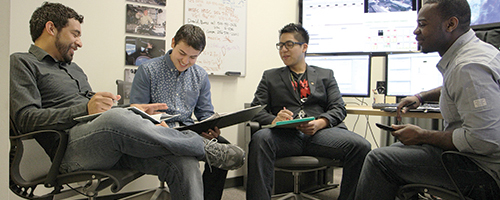U of O: moving in
Decades ago when state legislators realized that duplicate programs at multiple Oregon universities were tying up state dollars, the Oregon University System pressured schools to keep academic programs such as journalism and urban planning at only one campus.
Other institutions are wary of sharing these programs or partnering with relative newcomer Portland State, PSU administrators say, even as University of Oregon is bringing its classrooms to Portland.
Thanks to an anonymous $15 million donation in January, University of Oregon has $4.5 million to expand its acclaimed journalism program to its Portland campus. With many more internship opportunities than Eugene, UO’s Portland campus is a prime location for journalism students, who will join architecture and law students at the UO Portland Center’s diminutive four-story space.
As reported in The Daily Emerald, “[Portland] is where the market is if we want to fulfill our mandate to the state,” UO journalism professor Jim Van Leuven said, noting that UO has “pretty much the only full-blown journalism and communications programs in the state.”
The division of programs depends on each school’s mission, according to Lorraine Davis, UO’s vice president for academic affairs. As 2004-2005 chair of the Provosts’ Council, Davis has overseen academic affairs for the Oregon University System, the body that monitors the institutions. “Our mission is that we’re a comprehensive research university that serves the students. Architecture, allied arts, law, music, those are all professional areas that are the expected contributions to the state,” Davis said.
Outside of the core subjects taught at all universities, each institution has special programs. Portland State, for example, has the School of Urban and Public Affairs.
University of Oregon was established by the legislature in 1872, graduating its first class six years later. By the time Vanport College, which later became PSU, was established in 1948, UO had 76 years to develop its programs.
Besides a university’s original specialties and mission, money is an important determinant of what academic programs campuses have, said Terrell Rhodes, PSU vice provost for curriculum and undergraduate studies. “There’s been a real effort to not duplicate programs. Campuses would have to make a much stronger case [to start a new program] if it existed at another university.”
Rhodes remembers hearing debate about the journalism program when he came to Portland State two decades ago.
“I know there were some politics happening at the time,” Rhodes said. Twenty years ago, University of Oregon dwarfed PSU in every respect. PSU trails UO and OSU in research dollars and deep pocketed-alumni, but has passed up both in enrollment.
“At that time, the decision was made based on who had the existing resources,” Rhodes said. “And those things have changed now, but I don’t know of any proposals [to start a journalism program at PSU] or how much of a priority it is.”
Even in a climate of abundant state funding, convincing OUS that PSU should establish a journalism program would be difficult, but currently money is the largest factor.
“The thing that we’re encountering now is that even though we’re the largest university and have a lot of demand, the budgetary problems come into play,” Rhodes said. “We all have our own self-interest. Once you’re a well-established university, you’re less willing to partner. We would be pretty protective too in their position.”
“We’re in an enviable position, in a way. We struggle to accommodate all the students we have. Other campuses that aren’t located in a metropolitan area don’t have that advantage… for some schools, sharing programs is threatening.”
Rhodes says discussions about teaming up with UO in the architecture program have broken down repeatedly.
“That’s a classic one we’ve had going on for years. They keep trying to run a program up here but aren’t that interested in working with PSU. Their argument is that the existing program is well established, it’s good quality. The problem is most architecture firms are up here.”
As for whether UO’s architecture program in Portland cuts down on architecture student enrollment at PSU, “potentially it does,” Rhodes said. “That’s why PSU has been so interested in partnering… There’s a certain competitiveness that’s out there, for students and for tuition dollars.”
“The U of O has tended to resist joint programs,” Rhodes added. “Discussions tend to fall apart at the last minute.”
Nicholas Bittner, an architecture grad student at UO’s Portland Center, sees room for improvement both from the UO Eugene campus and Portland State. The 80 architecture students crammed into the UO Portland Center architecture studio pay fees that serve only Eugene students, he said, and can’t use facilities at PSU such as Stott Center. Bittner is president of Portland Student Action Council, which has filed grievances with UO administration over fee issues.
“There won’t be many journalism students up here,” Bittner said. “They don’t have the space.”




